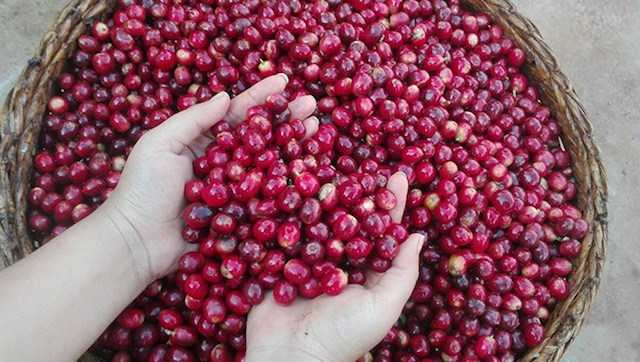Katim Coffee Flavor description Variety planting Development History Story introduction to Variety allusions in producing areas

For professional baristas, please follow the coffee workshop (Wechat official account cafe_style)
Catimor Katim (Katim)
Catimor: an important variety of commercial beans at present. East Timor was colonized by Portugal for 400 years, and the Portuguese had long been in contact with East Timorese coffee trees. In 1959, the Portuguese moved the Brazilian bourbon mutant Kadura to East Timor and interbred with Tim, who was of Robusta origin, and succeeded in breeding Kadim with strong disease resistance and super production capacity. During the period from 1977 ○ to 1999 ○, leaf rust affected coffee producing countries around the world. With the assistance of international organizations, various producing countries vigorously promoted Kadim to fight leaf rust and increase production capacity. However, although Katim inherited the advantages of Robusta's strong disease resistance, but also inherited the gene of poor flavor, in addition, although the early Katim had a large production capacity, it needed shade trees to serve, otherwise it was easy to wither, which can be said to be strong and dry. Over the decades, many botanists have studied the improvement of Kadim varieties, and dozens of new varieties have been cultivated. Colombia is the biggest harvester. In 1982, Kadim, which can be planted in the sun, was cultivated and named after the country "Colombia." Costa Rica claims that unlike ordinary kadim, [Colombia], which has been interbred for many generations, is now the two main varieties in the country with Kaddura, which has long replaced Tibica, which is weak, sickly and with low yield. However, most of the winners of Costa Rican [COE] are Kaddura, and [Colombia], who is of Robusta descent, rarely wins the prize. A large number of [Supermo] commercial beans exported by Costa Rica should be lower altitude [Colombia] or Kaddura, rather than the traditional Tibica, which is the main reason why the flavor of [Supermo] is getting poorer and poorer, but it is impossible for Costa Rica to reproduce the less productive Tibica.
In order to improve the poor evaluation of the Catimor Cartim Cup, in recent years botanists from all over the world have turned to the interbreeding of Arabica and Katim for many generations, in an attempt to reduce the Robusta pedigree and improve the elegant flavor of Arabica, thus cultivating a new generation of Katim, including [CatimorH528], [CatimorH306], and [CatimorT5175] and [CatimorT8667] of Costa Rica. But Costa Rica has abandoned the cultivation of Kadim, focusing on Kaddura varieties, and exporting the improved Kadim to Asian countries. There are countless Katim strains, and the cup test results and habits of each strain are also different, but although it has been improved for many years, Katim has not yet entered the top 30 list of the International Cup. Kadim's biggest fatal injury is that it is not inferior to Kaddura, Kaduai or bourbon beans grown at low altitude, but the cup test results planted at high altitude are significantly lower than those of bourbon, Kaduai or Kaddura. It remains to be seen whether Kadim can ascend to the Hall of Great elegance. Looking forward to one day to cultivate a super Kadim suitable for high altitude, shocked the boutique coffee industry.
It was hybridized with rust-resistant Timor and Caturra in Portugal in 1959. It has early maturity and strong disease resistance, and its yield is much higher than that of other varieties with commercial value. For this reason, we must be diligent in fertilization and pay attention to shading. The offspring of Catimor TMel 8667 are relatively short, but their fruits and seeds are very large. Catimor line TMel 5269 is very strong and suitable for growing in areas with an altitude of 600m-900m and annual rainfall of more than 3000 centimeters. The Tmur5175 is highly productive and robust, but it can be troublesome at too high or too low altitudes. At low elevations, its quality is similar to that of other varieties of commercial value, but above 1200 meters, its quality is much better than Bourbon, Caturra and Cauai.
From 26 to 28 February 2001, the Royal Planning Foundation of Thailand and the United Nations Food and Agriculture Organization jointly organized an event entitled "The First Asian Regional Round-Table on Sustainable, Organic and Speciality Coffee Production, Processing and Marketing" in Chiang Mai (the first Round Table on Sustainable, Organic and refined Coffee production, processing and Marketing in Asia). During the meeting, Dr Ernesto Illy, the boss of the Italian Illy Coffee Company, mentioned the poor quality of Cartimo coffee when giving a speech on "the negative factors in the quality of coffee raw beans." Because it has 25% robusta coffee gene, although it enhances the ability to resist rust, its quality is reduced by its influence.
Important Notice :
前街咖啡 FrontStreet Coffee has moved to new addredd:
FrontStreet Coffee Address: 315,Donghua East Road,GuangZhou
Tel:020 38364473
- Prev

Yunnan coffee bean variety flavor description history, present situation and development prospect
The exchange of professional baristas please follow the coffee workshop (Wechat official account cafe_style) two classic high-quality coffee varieties Typica and Bourbon are the main varieties of coffee in Yunnan. In 1991, the Katimo Catimor series were introduced from Kenya (more resistant to virus and higher yield). Arabian species (
- Next

Description of planting history by variety treatment of Rwandan coffee beans
Professional baristas please pay attention to the coffee workshop (Wechat official account cafe_style) Bourbon accounts for more than 90% of Rwanda's production. A small number of farmers grow bourbon variants BM-139 and Jackson. There are more mountains in the south and west, and water washing stations are also more famous. For example, Gitesi, Huye Mountain, Mibirizi, etc. Stone is common in Central America.
Related
- Detailed explanation of Jadeite planting Land in Panamanian Jadeite Manor introduction to the grading system of Jadeite competitive bidding, Red bid, Green bid and Rose Summer
- Story of Coffee planting in Brenka region of Costa Rica Stonehenge Manor anaerobic heavy honey treatment of flavor mouth
- What's on the barrel of Blue Mountain Coffee beans?
- Can American coffee also pull flowers? How to use hot American style to pull out a good-looking pattern?
- Can you make a cold extract with coffee beans? What is the right proportion for cold-extracted coffee formula?
- Indonesian PWN Gold Mandrine Coffee Origin Features Flavor How to Chong? Mandolin coffee is American.
- A brief introduction to the flavor characteristics of Brazilian yellow bourbon coffee beans
- What is the effect of different water quality on the flavor of cold-extracted coffee? What kind of water is best for brewing coffee?
- Why do you think of Rose Summer whenever you mention Panamanian coffee?
- Introduction to the characteristics of authentic blue mountain coffee bean producing areas? What is the CIB Coffee Authority in Jamaica?

